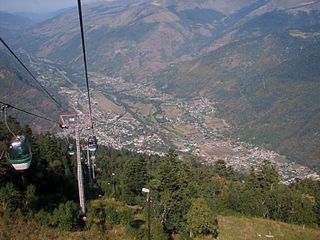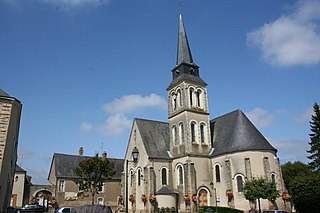
The Musée de Cluny, officially Musée de Cluny-Musée National du Moyen Âge, is a museum of medieval art in Paris. It is located in the 5th arrondissement of Paris, bordered by square Samuel-Paty to the south, boulevard Saint-Michel to the west, boulevard Saint-Germain to the north, and rue Saint-Jacques to the east.

Lutetia, also known as Lutecia and Lutetia Parisiorum, was a Gallo–Roman town and the predecessor of modern-day Paris. Traces of an earlier Neolithic settlement have been found nearby, and a larger settlement was established around the middle of the third century BC by the Parisii, a Gallic tribe. The site was an important crossing point of the Seine, the intersection of land and water trade routes.

The Thermes de Cluny are the ruins of Gallo-Roman thermal baths lying in the heart of Paris' 5th arrondissement, and which are partly subsumed into the Musée national du Moyen Âge - Thermes et hôtel de Cluny.

Rennes-les-Bains is a commune in the Aude department in southern France.
The Pillar of the Boatmen is a monumental Roman column erected in Lutetia in honour of Jupiter by the guild of boatmen in the 1st century AD. It is the oldest monument in Paris and is one of the earliest pieces of representational Gallo-Roman art to carry a written inscription.

Bagnères-de-Luchon, also referred to as just Luchon, is a commune and spa town in the Haute-Garonne department in the Occitanie region of south-western France.

Bavay is a commune in the Nord department in the Hauts-de-France region of northern France. The town was the seat of the former canton of Bavay.

Laval Agglomération is the communauté d'agglomération, an intercommunal structure, centred on the city of Laval. It is located in the Mayenne department, in the Pays de la Loire region, western France. It was created in 2001 as the Communauté d'agglomération de Laval. It was merged with the former communauté de communes du Pays de Loiron to form the communauté d'agglomération Laval Agglomération on 1 January 2019. Its area is 686.1 km2. Its population was 113,854 in 2016, of which 49,573 in Laval proper.

The arrondissement of Laval is an arrondissement of France in the Mayenne department in the Pays de la Loire region. It has 34 communes. Its population is 112,937 (2016), and its area is 686.1 km2 (264.9 sq mi).

Barzan is a commune in the Charente-Maritime department in the Nouvelle-Aquitaine region of south-western France.

Gilles de la Pommeraie was a 16th-century French diplomat and Baron d'Entrammes.

Montoulieu-Saint-Bernard is a commune in the Haute-Garonne department of southwestern France.

The Saint-Étienne Church is a church in Entrammes, Mayenne, France.

The Jublains archeological site is a cluster of ruins, mostly dating back to Ancient Rome, in the current French commune of Jublains in the département of Mayenne in the Pays de la Loire.
Excavations took place at the oppidum de Moulay or oppidum du Mesnil, an oppidum in the commune of Moulay in the Mayenne in the Pays de la Loire region between 1972 and 1975, when the commune was subdivided. The excavation of the first rampart uncovered suggestions an area of 12 hectares, as well as a number of artifacts now exhibited at the Musée archéologique départemental de Jublains. On 26 May 1986, the site was declared a monument historique.

The Roman waystation of Rubricaire in eastern Gaul, the first core of a series of successive settlements that came into being at the foot of Mont Rochard, is better known through its ruins than through historical texts. Also known as the château de Rubricaire, it was the seat of Sainte-Gemmes-le-Robert, in the canton of Évron in (Mayenne), 11 kilometers as the bird flies from, and within sight of, the Jublains archeological site in Mayenne, chief settlement of the Aulerci Diablintes.

Maurice-Mollard Plaza, named after a former mayor of the town, is a public square in the historical center of Aix-les-Bains, in western Savoy. Rich in history, the square has undergone many changes over the centuries. It is home to a number of architectural monuments, some of which are listed as historical monuments: the Arch of Campanus and the Temple of Diana date back to Roman times; the 18th-century National Thermal Baths were partially built on the foundations of former Roman thermal baths; and the Town Hall which was originally a feudal castle. The latter is also home to an archaeological museum housing the Roman remains of Aquae, the ancient name of Aix-les-Bains.

The ancient baths of Alauna are a Gallo-Roman thermal complex located in the French commune of Valognes in the north of Manche.

The Gallo-Roman forum of Vieux-la-Romaine belongs to the archaeological site of the ancient Aregenua, situated approximately 11 km south of Caen.

The Bliesbruck baths, discovered in the commune of the same name in the French department of Moselle, in the Grand Est region, are a Roman thermal complex that was in operation from the late 1st century to the mid-3rd century.





















